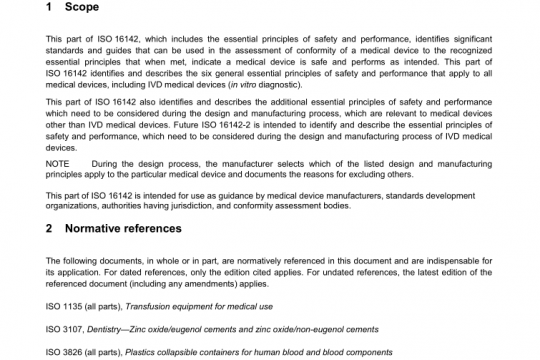AAMI ISO 10993-1 pdf free download
AAMI ISO 10993-1 pdf free download.Biological evaluation of medical devices—Part 1: Evaluation and testing within a risk management process.
4 General principles applying to biological evaluation of medical devices 4.1 The biological evaluation of any material or medical device intended for use in humans shall form part of a structured biological evaluation plan within a risk management process in accordance with ISO 14971:2007, Annex I, as given in Figure 1 of this document. This risk management process involves identification of biological hazards, estimation of the associated biological risks, and determination of their acceptability. Annex B provides guidance on this process. The biological evaluation shall be planned, carried out, and documented by knowledgeable and experienced professionals. The risk management plan should identify aspects of the biological evaluation requiring specific technical competencies and shall identify the person(s) responsible for the biological evaluation. The evaluation shall include documented, informed consideration of advantages/disadvantages and relevance of: a) medical device configuration (e.g. size, geometry, surface properties) and a listing of a medical device’s materials of construction (qualitative) and where necessary, the proportion and amount (mass) of each material in the medical device (quantitative); b) the physical and chemical characteristics of the various materials of construction and their composition; NOTE Where this information is already documented within the risk management for the medical device, it can be included by reference. c) any history of clinical use or human exposure data; NOTE Previous regulatory approval history can be relevant. d) any existing toxicology and other biological safety data on product and component materials, breakdown products and metabolites;e) test procedures. Evaluation can include both a review of relevant existing preclinical and clinical data and actual testing. Such an evaluation might result in the conclusion that no testing is needed if the material has a demonstrable safe history of use in a specified role and physical form that is equivalent to that of the medical device under design. The type of information that can be useful to demonstrate equivalence is included in Annex B. Testing is usually not necessary when sufficient information is already available to perform a risk assessment of the material and/or the medical device (see Annex C). 4.2 In the selection of materials to be used in the medical device manufacture, the first consideration shall be fitness for purpose with regard to characteristics and properties of the material, which include chemical, toxicological, physical, electrical, morphological and mechanical properties. 4.3 The following shall be taken into account for their relevance to the overall biological evaluation of the medical device: a) the material(s) of construction (i.e. all direct and indirect tissue contacting materials); b) intended additives, process contaminants and residues (for example, testing for ethylene oxide sterilization residuals shall be conducted in accordance with ISO 10993-7); c) packaging materials that directly or indirectly contact the medical device can transfer chemicals to the medical device and then indirectly to the patient or clinician;d) leachable substances (see ISO 10993-17 and ISO 10993-18); e) degradation products (see ISO 10993-9, for general principles and 10993-13, 10993-14 and 10993-15 for degradation products from polymers, ceramics and metals, respectively); f) other components and their interactions in the final product; g) the performance and characteristics of the final product; h) physical characteristics of the final product, including but not limited to, porosity, particle size, shape and surface morphology. Description of medical device chemical constituents and consideration of material characterization including chemical characterization (see ISO 10993-18) shall precede any biological testing (see Figure 1). Chemical characterization with an appropriate toxicological threshold can be used to determine if further testing is needed (see Annex B, ISO 10993- 17 and ISO 10993-18).AAMI ISO 10993-1 pdf download.
Other IEC Standards
-

ANSI AAMI ISO 16142-1 pdf free download – non-IVD medical devices and guidance on the selection of standards
AAMI standards list DOWNLOAD -

ANSI AAMI ISO 16142-2 pdf free download – General essential principles and additional specifc essential principles
AAMI standards list DOWNLOAD


